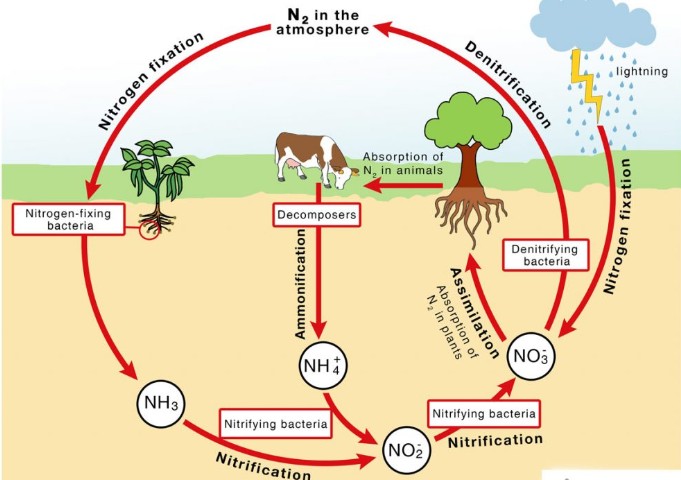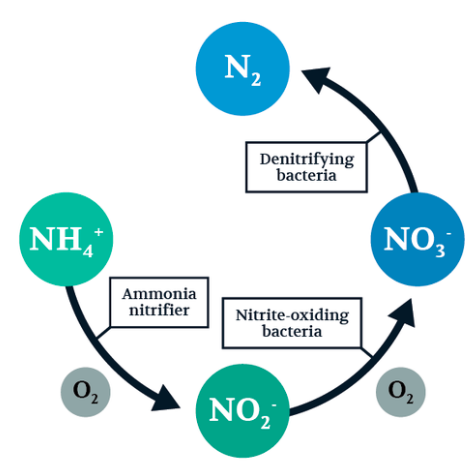Introduction
Nitrogen (N2) is the most abundant though crucial to living things element that can be found in the water, air, and soil. To a great extent, the nitrogen cycle is a systematic biochemical process under which nitrogen is converted into several usable forms, including nitrates and nitrites. Such nitrogen forms are constantly transitioning via the atmosphere to the soil and the living organisms and back to the atmosphere (Hutchins and Capone, 2022). At the same time, in the present day, people alter the nitrogen cycle and reproduce it stages for industrial purposes. For instance, an artificial nitrogen fixation, or the Haber–Bosch process, may be regarded as the main procedure for a manmade production of ammonia. However, individuals’ alteration of the global nitrogen cycle has adverse impacts, including escalated uncertainty of infectious and parasitic ailments among animals and people.
Elements of the Global Nitrogen Cycle
The atmosphere is nitrogen gas’s largest reservoir; nitrogen gas enters soil via particular bacteria and plant roots to be converted into ammonia within the process of nitrogen fixation. Subsequently, it is converted to nitrite and nitrate by other bacteria. Animals receive nitrogen compounds from other animals they eat or plants, and release nitrogen to the soil again when die or in the form of waste. Decomposed by fungi and bacteria, nitrogen returns to the atmosphere again. The whole cycle is presented in Picture 1.


Figure 1 illustrates the main components of the global nitrogen cycle. The first element is nitrogen fixation, where the nitrogen in the air moves into the soil. Even though the atmospheric nitrogen is approximately 78%, it cannot be utilized by plants since N is gaseous (Hutchins and Capone, 2022). Therefore, for nitrogen to be used by plants, N2 must undergo nitrogen fixation, where nitrogen in the atmosphere is converted into either nitrogen dioxide (NO2) or nitrogen oxide (NO) through lightening, which plants in the soil can easily absorb. In most cases, nitrogen fixation occurs inherently in the soil, where diazotrophs, a symbiotic bacterium, assist in completing the process.
Another crucial element of the nitrogen cycle is mineralization, where gaseous nitrogen transitions from organic materials, including manure, to inorganic nitrogen forms that plants can utilize. During this phase, the microbes start converting animal manure into beneficial nitrogen forms, such as ammonium (NH4+), which help plant growth (Wang et al., 2018). One more crucial component of the nitrogen cycle is ammonification. After the animals and plants die, they start decomposing, and the nitrogen available in the organic matter is released into the soil. Fungi and bacteria in the ground, which are the primary decomposers, assist in converting the organic matter into ammonium.
Immobilization is a vital element of the nitrogen cycle and can be described as reverse mineralization. The process aids in regulating the amount of N2 in the ground. The soil microorganisms utilize nitrogen as their energy source, particularly when decomposing plant residues lack adequate nitrogen (Zehr and Capone, 2020). To a great extent, immobilization is essential as it assists in the balance and control of the amount of nitrogen in the soil. Figure 2 illustrates the conventional denitrification and denitrification reaction route.

The other essential element of the nitrogen cycle is nitrification, where bacteria in the soil convert ammonia into nitrate. Nitrification is a vital process as it aids in detoxifying ammonia, which is harmful to plants as it absorbs water from them. Notably, nitrification benefits plant as it produces an extra stash of available nitrogen directly absorbed via plant roots (Hutchins and Capone, 2022). Lastly, another crucial element for the global nitrogen cycle is denitrification. The nitrogen returns to the air during this stage since bacteria convert nitrates into N2.
Have Altered Nitrogen Cycle
With scientific and technological development, humans receive an ability to reproduce the stages of the nitrogen cycle for industrial purposes. In particular, at the beginning of the 20th century, Carl Bosch and Fritz Haber invented an artificial nitrogen fixation for the production of synthetic ammonia for chemical fertilizers. Under high temperatures and high pressures, nitrogen gas (N2) is converted to ammonia (NH3) (Zhang, Ward, and Sigman, 2020). On the one hand, the reproduction of the cycle’s stage had multiple industrial benefits for people. On the other hand, it led to the alteration of the nitrogen cycle that presupposed the increase of fixed nitrogen in ecosystems.
There are various ways in which people have altered the nitrogen cycle. Notably, agricultural fertilizers are the most significant contributor to the cycle’s highly escalating amount of nitrogen. Even though many farmers have extensive knowledge that the availability of nitrogen in the soil aids in the development of crops, most of them have continued to utilize them excessively while cultivating their land resulting in pollution (Lehnert et al., 2018). Using nitrogen-based fertilizers has resulted in excessive nitrogen production, which impacts the nitrogen fixation process as the survival rates of microorganisms deteriorate (Taylor and Menge, 2018). The extra nitrogen used in multiple worldwide farmlands is being forced into the nitrogen cycle, posing a substantial threat to the stability and balance of the earth’s ecosystems.
Individuals have modified the nitrogen cycle through fossil fuel combustion as well. The excessive burning of fossil fuel has significantly contributed to the global reaction of nitrogen load. Fossil fuels, such as crude oil, coal, and natural gas combustion, release nitric oxides into the atmosphere, leading to acid rain, which kills microorganisms involved in the immobilization and mineralization processes (Hutchins and Capone, 2022). The massive nitrogen isotopes found in the nitrates emitted while burning fossil fuels impact the nitrogen cycle, whereby nitrogen cannot be disintegrated into usable forms, which aid in the growth of plants. Moreover, the burning of biomass releases harmful greenhouse gases into the atmosphere, such as nitrous oxide, which causes the formation of photochemical smog in various areas, causing delayed growth among plants (Zehr and Capone, 2020). The action causes a massive delay in the oxidation process required in the nitrification and nitrogen fixation process.
Alterations Consequences for the Earth System
Regarding the biosphere, which entails living things, the altering nitrogen cycle can cause the generation of different forms of nitrogen which cause health problems for people. To a great extent, nitrate pollution of underground water due to the massive use of fertilizers when consumed by people causes high blood pressure (Taylor and Menge, 2018). The high levels of nitrates in underground drinking water have adverse human health issues, mainly for toddlers. The available microbes help convert substantial nitrates into nitrites, which are absorbed into the bloodstream. Nitrites transform the oxygenated hemoglobin into ineffective methemoglobin, thus causing methemoglobinemia, damaging one’s brain, and even resulting in death.
Most of the nitrogen used in agricultural areas enters coastal waters and rivers. High nitrogen loadings result in eutrophication, especially in stratified waters, where increased temperatures prevent cold bottom waters from mixing with warm surface waters, causing marine animals not to have adequate oxygen (Zhang, Ward, and Sigman, 2020). The increased rate of nitrogen can result in hypoxia (low oxygen) and anoxia (lack of oxygen), transformation in food-web structure, biodiversity distortion, and overall habitat degradation (Hutchins and Capone, 2022). Nevertheless, one of the crucial repercussions of escalated nitrogen is the elevation of harmful algal blooms, which are highly associated with shellfish and fish mortality.
In terrestrial ecosystems, extra nitrogen results in biodiversity loss, the transformation of forest health, and nutrient imbalance in trees. Various forms of nitrogen, including nitrites, impact natural ecosystems, whereby reduced forest productivity causes carbon sequestration. For example, the high nitrite concentrations cause deterioration in trees’ biochemistry, growth, biomass, and physiology, which lowers the forest yield, contributing to global warming (Taylor and Menge, 2018). Modifying the nitrogen cycle has resulted in acidification – nitric acid significantly causes acid rain, which seeps into the soil, causing into dissolving of vital nutrients, such as calcium and magnesium, required for the growth of trees (Lehnert et al., 2018). The acid rain releases massive amounts of aluminum into the ground, making it challenging for trees to uptake water.
Conclusion
The global nitrogen cycle has several main elements, including nitrogen fixation, denitrification, nitrification, ammonification, mineralization, and immobilization. There are various ways in which people have altered the nitrogen cycle, including extensive use of fertilizers and frequent burning of fossil fuels. However, people’s modification of the global nitrogen cycle has adverse effects, such as an increased risk of parasitic and infectious ailments among individuals and animals.
Reference List
Hutchins, D. A., and Capone, D. G. (2022) ‘The marine nitrogen cycle: new developments and global change’, Nature Reviews Microbiology, 5(8), pp. 1-14.
Lehnert, N. et al. (2018) ‘Reversing nitrogen fixation’, Nature Reviews Chemistry, 2(10), pp. 278-289.
Taylor, B.N. and Menge, D.N. (2018) ‘Light regulates tropical symbiotic nitrogen fixation more strongly than soil nitrogen’, Nature Plants, 4(9), pp. 655-661.
Wang, M. et al. (2018) ‘A global perspective on agroecosystem nitrogen cycles after returning crop residue’, Agriculture, Ecosystems & Environment, 266(30), pp. 49-54.
Yang, J. et al. (2020) ‘A critical review of aerobic denitrification: insights into the intracellular electron transfer’, Science of The Total Environment, 731(5), pp. 139-150.
Zehr, J. P., and Capone, D. G. (2020) ‘Changing perspectives in marine nitrogen fixation’, Science, 368(62), pp. 9514-9520.
Zhang, X., Ward, B. B., and Sigman, D. M. (2020) ‘Global nitrogen cycle: critical enzymes, organisms, and processes for nitrogen budgets and dynamics’, Chemical Reviews, 120(12), pp. 5308-5351.